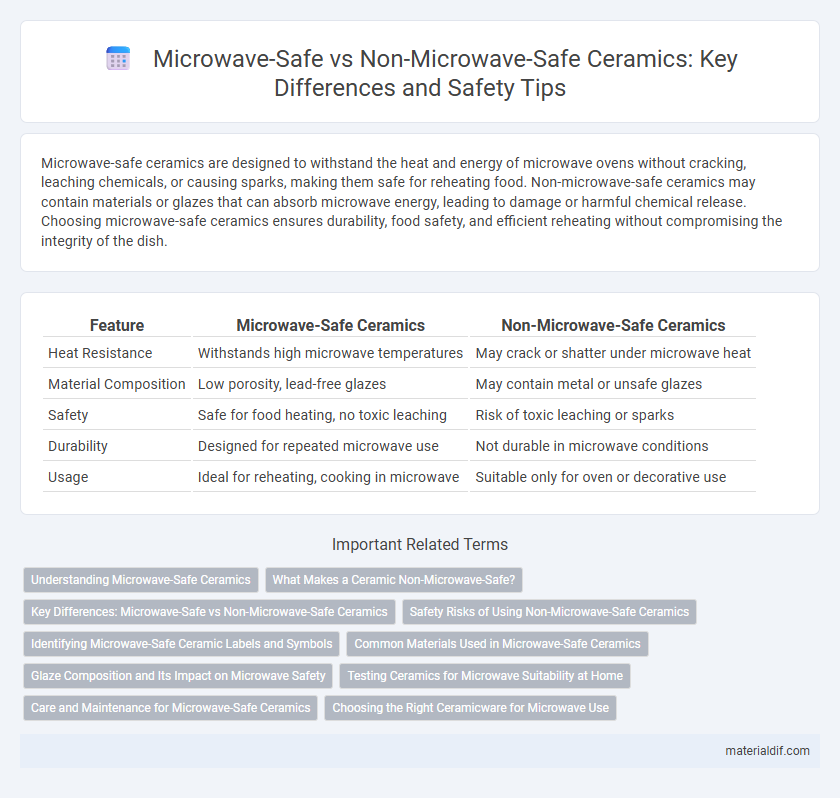Microwave-safe ceramics are designed to withstand the heat and energy of microwave ovens without cracking, leaching chemicals, or causing sparks, making them safe for reheating food. Non-microwave-safe ceramics may contain materials or glazes that can absorb microwave energy, leading to damage or harmful chemical release. Choosing microwave-safe ceramics ensures durability, food safety, and efficient reheating without compromising the integrity of the dish.
Table of Comparison
| Feature | Microwave-Safe Ceramics | Non-Microwave-Safe Ceramics |
|---|---|---|
| Heat Resistance | Withstands high microwave temperatures | May crack or shatter under microwave heat |
| Material Composition | Low porosity, lead-free glazes | May contain metal or unsafe glazes |
| Safety | Safe for food heating, no toxic leaching | Risk of toxic leaching or sparks |
| Durability | Designed for repeated microwave use | Not durable in microwave conditions |
| Usage | Ideal for reheating, cooking in microwave | Suitable only for oven or decorative use |
Understanding Microwave-Safe Ceramics
Microwave-safe ceramics are specifically formulated to withstand heat generated by microwave radiation without cracking or leaching harmful substances. These ceramics typically contain low levels of metal oxides and are free from lead or cadmium glazes, ensuring food safety during microwave use. Identifying microwave-safe ceramics involves checking for manufacturer labels, testing for heat retention, and understanding material composition to prevent damage and health risks.
What Makes a Ceramic Non-Microwave-Safe?
Non-microwave-safe ceramics often contain metallic glazes or materials that cause sparks and heat damage in microwave ovens. The presence of lead or cadmium in certain ceramic glazes can release harmful toxins when heated, making them unsafe for microwave use. Porosity and uneven moisture absorption in some ceramics can lead to cracking or explosions due to rapid temperature changes during microwaving.
Key Differences: Microwave-Safe vs Non-Microwave-Safe Ceramics
Microwave-safe ceramics are specifically formulated to withstand high temperatures and rapid heating without cracking or leaching harmful substances, ensuring safe food warming. Non-microwave-safe ceramics often contain glazes or materials that can absorb microwave energy, potentially causing uneven heating, cracking, or release of toxins. Understanding the material composition and manufacturer guidelines is essential to avoid damage and ensure optimal safety when using ceramics in microwaves.
Safety Risks of Using Non-Microwave-Safe Ceramics
Non-microwave-safe ceramics can contain materials that absorb microwave energy unevenly, causing cracks, explosions, or harmful chemical leaching, which pose significant safety hazards. These ceramics often lack the heat-resistant glaze required to withstand rapid temperature changes, increasing the risk of burns and dish breakage. Using certified microwave-safe ceramics minimizes exposure to toxic elements like lead and cadmium, ensuring safer food heating and preventing contamination.
Identifying Microwave-Safe Ceramic Labels and Symbols
Microwave-safe ceramics typically feature labels such as a microwave symbol, wavy lines, or explicit text indicating microwave compatibility on their packaging or base. Non-microwave-safe ceramics lack these identifiers and may include metallic decorations that cause sparks or heat unevenly. Recognizing these symbols ensures safe heating, prevents ceramic damage, and avoids hazardous microwave use.
Common Materials Used in Microwave-Safe Ceramics
Microwave-safe ceramics often include materials such as porcelain, stoneware, and certain types of earthenware that are fired at high temperatures to enhance durability and heat resistance. These ceramics typically have low water absorption rates and contain minimal metallic elements to prevent sparks or damage in microwave ovens. Common additives like glaze coatings improve microwave safety by providing a non-porous, heat-resistant surface, distinguishing them from non-microwave-safe ceramics that may crack, absorb moisture, or release harmful substances when heated.
Glaze Composition and Its Impact on Microwave Safety
Microwave-safe ceramics feature glazes formulated with non-metallic oxides, such as silica and alumina, which prevent arcing and heat buildup during microwave use. Non-microwave-safe ceramics often contain metallic compounds or lead-based glazes, increasing the risk of sparks and uneven heating. The chemical composition of the glaze directly affects a ceramic's ability to withstand microwave energy without damage or safety hazards.
Testing Ceramics for Microwave Suitability at Home
Testing ceramics for microwave suitability at home involves placing the ceramic item alongside a cup of water in the microwave and heating for one minute on high. If the ceramic remains cool while the water heats, the item is likely microwave-safe; if the ceramic becomes hot, it indicates non-microwave-safe material that may absorb microwave energy and risk cracking or releasing harmful substances. Using microwave-safe ceramics ensures durability and safety during reheating or cooking processes.
Care and Maintenance for Microwave-Safe Ceramics
Microwave-safe ceramics require careful handling to prevent thermal shock, such as avoiding sudden temperature changes and using microwave-safe lids to retain moisture. Cleaning with non-abrasive sponges and mild detergents preserves the glaze and prevents cracks or discoloration. Regular inspection for chips or cracks ensures continued safety and microwave compatibility, as damaged ceramics can absorb microwaves unevenly.
Choosing the Right Ceramicware for Microwave Use
Microwave-safe ceramics are specifically designed to withstand high temperatures without cracking or releasing harmful chemicals, making them ideal for reheating food. Non-microwave-safe ceramics may contain metallic glazes or materials that cause uneven heating, sparking, or damage to the microwave. Choosing ceramicware labeled as microwave-safe ensures durability, safety, and optimal performance during microwave use.
Microwave-Safe Ceramics vs Non-Microwave-Safe Ceramics Infographic

 materialdif.com
materialdif.com